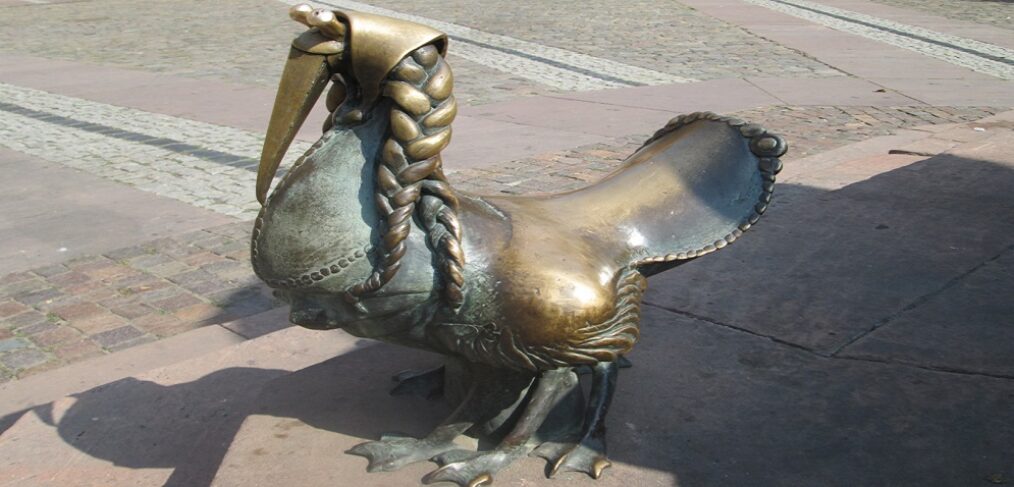
species of the week # 42 – elwetrisch
In the Palatinate Forest live little goblins who used to help the poor winegrowers out of many a tricky situation, but also drove many a citizen to despair with their pranks. This little people, called Elwedritsche, still exists. It has a vital population in the Palatinate Forest. Around Christmas, the Elwetritsch appears again and again in Palatine stories.
| Distribution status | Alive, especially around Christmas |
| Remaining occurances | Palatinate Forest, Neustadt, Primasens, Landau, Wernigerode |
| Last sighting in rhineland-palatinate | unknown |
| Habitat | Palatinate vineyards and wineries |
| Threat | hunting, full harvester, humorlessness |
The Elwetrisch is a mythical creature, and resembles a cross between a duck, goose, pheasant, fairy and troll. It migrated to the United States as an invasive species with the Palatine emigrants. Especially in Amish and Pennsylvian Dutch, “Elbetrians” are a concise part of narratives. The painter Max Slevogt was the first artist to immortalize Elwetrites as a pen and ink drawing in a book of poetry by Eugen Fried. Photos of the minnows are almost impossible to take because of their shy nature. However, the Landau tritschologists of the Elwetrischen Verein have described five particular subspecies of Elwetrisch as part of scientific literature research.
1) Altrheintritsche: Live mainly on the side arms of the Rhine (Altrhein). They reach about the size of ducks. They have webbed toes and feed on lichens, mosses, silt, and also insects such as gnats and horseflies.
2) Burgundy Tritch: Their habitat is vineyards/vineyards in the Palatinate and Rheinhessen. It is currently the largest known tritch species and reaches heron to stork size on average. The Burgundy tritch feeds on berries of the various Burgundy grape varieties such as Pinot Gris, Pinot Blanc, Pinot Noir, Early Burgundy in solid, as well as readily in liquid form.
3) Böchinger Hangtritsche – otis palatinensis: In the vernacular it is also called “Keschdetritsch”, because it feeds with preference on chestnuts, acorns and beechnuts. Special are the up to three pairs of legs, which it can extend to the valley side and shorten to the slope side. It is the only species with teeth in its beak, which it uses to mash its food. Their eggs are “spiked” (similar to chestnut pods) so that nest predators don’t have it too easy.
4) Chaussee Ditch Ditch / Common Field Ditch: It is found primarily in roadside ditches, drainages, and small stream channels. It is only the size of a partridge and is often mistaken for one. Its plumage is inconspicuous, mottled gray-brown. Its retreats include shrubs, bushes, as well as hedges, where it also mainly finds its food.
5) Cathedral Garden Flycatcher: Sightings in the Speyer Cathedral Garden and cemeteries. Its plumage resembles that of the bullfinch: striking black and red. It is hunted particularly heavily because of its attractive plumage.
The hunting procedure is as follows: The first requirement is a cold, clear full moon night. The hunt participants gather quite early in a cozy inn at the edge of the forest. Here they discuss and drink, think and drink. By midnight, it must be decided who will be the catcher. All the others are the beaters. The catcher stands at a pre-arranged spot, armed with a sturdy jute bag and a barn lantern. The beaters form a wide circle and, shouting loudly, chase the frightened elwetrites out of the undergrowth toward the catcher. Then they are quiet as mice and retreat so that the animals can approach the mysterious bag in peace. The trapper now tries to lure the minnows into the big bag with the most provocative cooing and courtship calls. Here he needs great patience and empathy. Some of them are still standing at dawn, cooing and warbling, because they do not dare to return without any prey. In the meantime, the other members of the hunting party have long since returned to sitting with wine in the inn, amused by the fatuity of the catcher.
Politically necessary:
Put your feet up, sip your dubbin glass and watch
Image: By AnRo0002 – Own work, CC0, https://commons.wikimedia.org/w/index.php?curid=72807577
